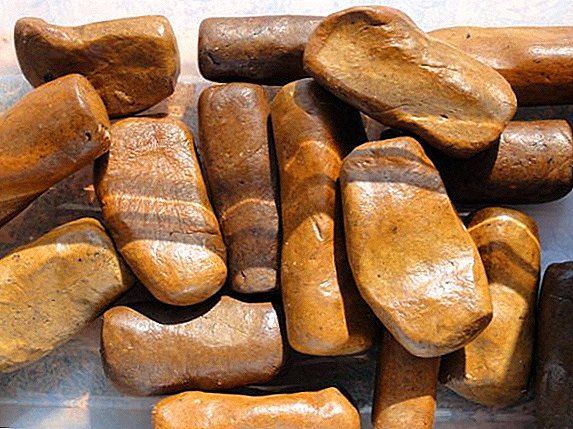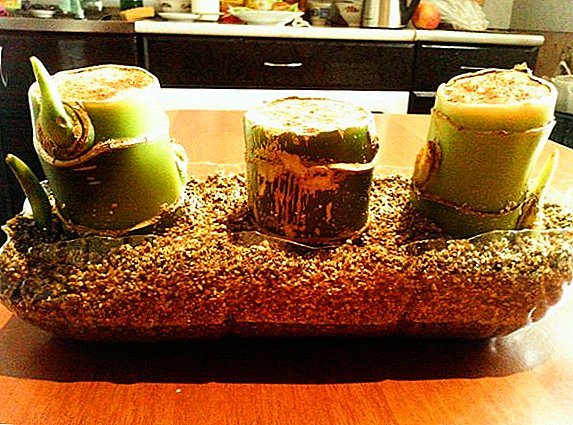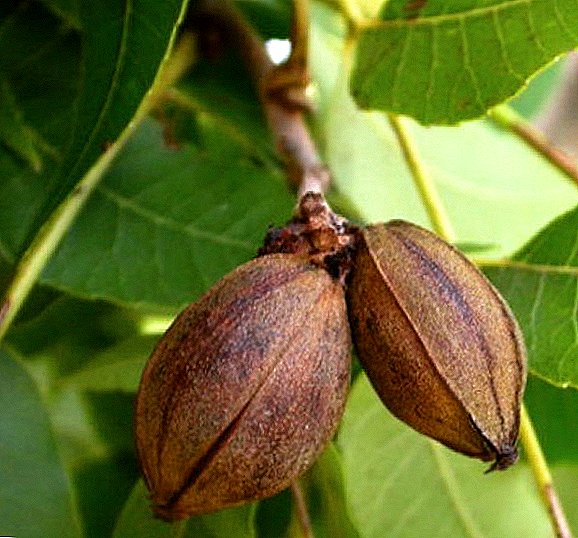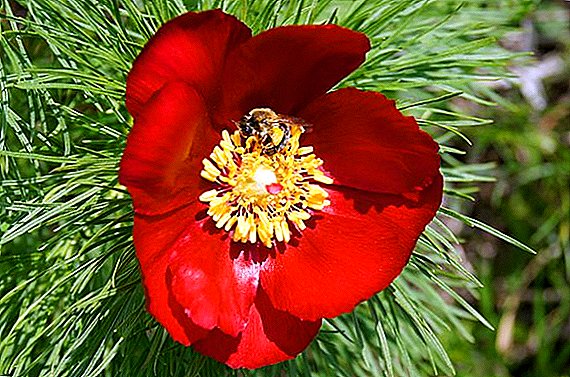 There are not so many flower growers and healers who know the true value of the narrow-leaved peony. And the population of the plant itself is rapidly declining.
There are not so many flower growers and healers who know the true value of the narrow-leaved peony. And the population of the plant itself is rapidly declining.
Today, the wild peony is better known as the flower listed in the Red Book. The reason for this phenomenon is paradoxical: somewhere in the 70-80s, large-flowered peonies ousted the medicinal peony from gardens and gardens.
Nevertheless, funnels - a powerful healer with high pharmacological properties, is popular in medicine and herbal medicine. Consider what is its healing power.
Plant description
Thin-leaved peony - the inhabitant of the wild nature. In gardening it is most often used for decorative purposes. This is a perennial herb of the Pionov family.
The growth of the funnel is from 20 to 50 cm, and its roots have a characteristic pineal shape. He prefers stony or steppe areas, forest edges. 
Decorative properties are distinguished not only by rich red or purple peony flowers, about 5 cm in diameter, but also its trifoliate leaves, which have been dipped down. The huge five-petalous bright flower with the yellow core looks great on a green "carpet".
Your garden will also be decorated with perennials such as: willows, gravel, cornflower, hionodoksa, tuberose, Armeria, tufted, spruce, doronicum, acanthus, uvulyaria.Funnels bloom mostly in May. But maybe sooner or later. It all depends on the climatic conditions of habitat. Sometime in July, seed boxes of attractive coffee color appear in the form of 2-3 fluffy leaflets on faded stems.
Chemical composition
Despite its wide use in medicine, the black cohosh is a plant whose chemical composition has been studied too poorly. Modern science knows that the "azure flower" is characterized by the presence of tannins, flavonoids, in particular quercetin, kaempferol, ranunkulin, flavescetin.
Fresh peony leaves are the reservoir of ascorbic acid, and root cones contain cardiac glucosides. 
Did you know? It should be noted that the plant attracts attention not only rich in chemical composition, but also leads in the number of names: funnels, black cohosh, greenery, lazur flower, lazorica, steppe, fern or wild peony, Marin root.
Pharmacological properties
Peony has long been known as a remedy and in every way used for medicinal purposes. The plant is effective in combating epilepsy, anemia, kidney disease (kidney stones), hemorrhoids.
Also used in the treatment of anal fissure and rectum fissures. Contributes to the normalization of the menstrual cycle of women. Effective in the prevention of cardiovascular diseases.
It is also worth mentioning that peony drugs have sobering abilities and help to quickly get rid of the effects of alcohol consumption.
Important! Practically all parts of the funnel have therapeutic properties. But do not get involved in self-treatment. For example, curative peony tincture can bring harm instead of benefit. The fact is that the plant is poisonous, which folk healers often forget.

Pharmaceuticals with ravents
For therapeutic purposes, pharmacists produced peony tincture, which is in great demand in pharmacies. This drug helps to cure patients of gynecologists, psychiatrists, urologists, nephrologists, gastroenterologists, and neurologists.
Funnels present in the composition of drugs that are used for diseases of the joints. The azure flower is also used to make preparations that are used in the treatment of cancer, and more specifically, the elimination of the effects of chemotherapy.
How to use the peony in traditional medicine
In folk medicine, funnels are much more in demand than in pharmacology. Healers make tinctures and decoctions of the roots, flowers, leaves, peony petals, focusing exclusively on the medicinal properties of the plant and often neglecting contraindications.
Did you know? It is worth noting that in the folk view, the black crow is not only a medicine, but also the source of many legends. For example, the Chinese are confident that the peony is able to expel evil spirits and is considered the royal flower in this country, in Japan and Greece they interpret lazorica as a symbol of happiness and wealth.
Ointment
The ointment made from the funnel is effective in eliminating the effects of fractures, is capable of healing the bones, and is used in the treatment of trigeminal and sciatic nerves.  Ointment is made exclusively from the roots of the plant. To do this, they need to be well washed, dried and grated. Mix ground root with pork inner fat (1: 1) and insist on a water bath in a closed container for 30 minutes.
Ointment is made exclusively from the roots of the plant. To do this, they need to be well washed, dried and grated. Mix ground root with pork inner fat (1: 1) and insist on a water bath in a closed container for 30 minutes.
Decoction
The decoction of medicinal peony is effective in the treatment of epilepsy, convulsions, spasms, rapid heartbeat. It is also used in case of insufficient urination and in the process of dealing with gout.
For the treatment of gout are also used such medicinal plants as: autumn crocus, veronica drug, kupena, vervain.
To prepare the broth, you will need a dried root funnel, about 20-40 g. The substance is poured with a liter of water, boiled and filtered. It is necessary to take this medicine 3 times a day for half a glass.
But we must not forget that the peony root has both healing properties and contraindications. Therefore, self-medication can be detrimental. It is worth to start excellently study the features of your body and treat it only under strict medical supervision. 
Infusion
Infusion lazorica is most often used in the treatment of heart disease. It is made from root cones. One teaspoon of crushed roots must be poured 400 ml of boiling water and let boil for 5 minutes. After that, strain and take half a glass 3 times a day.
In addition, it is also possible to prepare an infusion from the herbaceous part of the plant. For this you need 1 tsp. raw materials diluted in 3 cups boiling water, 30 minutes to insist, drain and take 1 tbsp. l 5-10 minutes before a meal.
The prepared tool improves appetite and improves the digestive process. Take these funds with extreme caution.
Tincture
Peony tincture is best to buy at the pharmacy. If desired, it can be made independently. But do not forget that such an occupation requires special care and responsibility.
Ingredients for tincture:
- 20 g of crushed leaves, roots, stems, flowers funnel;
- 200 ml of vodka.

Important! This tool is particularly effective in the treatment of neurasthenia or mental illness. The treatment process should be carried out under the strict supervision of doctors.
Tea
In order to prevent colds and strengthen the immune system, you can drink tea with peony. For its preparation you need only the ground part of the funnel. Tea leaves are easy. You just need to fill the raw material with hot water and boil.
Harm and contraindications
Voronove is a toxic plant. Even the slightest deviation from the recommendations of the doctor and dosages can cause harm to your body.
It should be remembered that folk remedies from peony are contraindicated in such categories of people:
- suffering from increased acidity of the stomach, pancreatitis;
- hypotension patients;
- people with diseased liver and kidneys;
- pregnant and lactating medicines from voronets are strictly prohibited;
- alcohol-dependent;
Receiving funds from the funnel can cause a number of side effects, including excessive drowsiness, exhaustion, bouts of vomiting and nausea, abdominal discomfort, a sharp drop in pressure, and allergic reactions.  So inconspicuous and rare flower, as you can see, is the source of many useful substances that are in wide demand among physicians and healers. But only a properly organized treatment process can be beneficial, otherwise you only harm yourself.
So inconspicuous and rare flower, as you can see, is the source of many useful substances that are in wide demand among physicians and healers. But only a properly organized treatment process can be beneficial, otherwise you only harm yourself.












